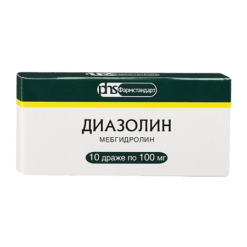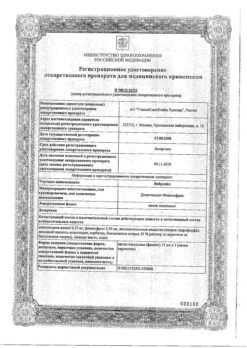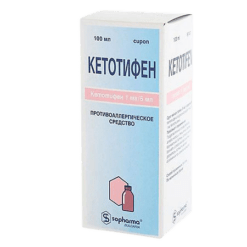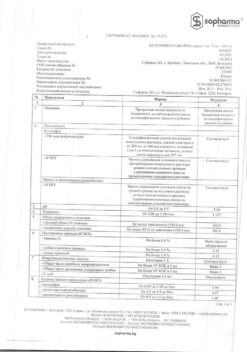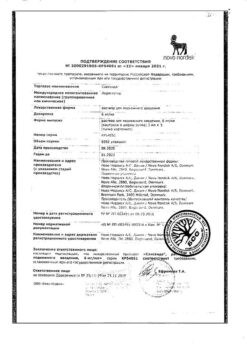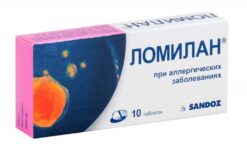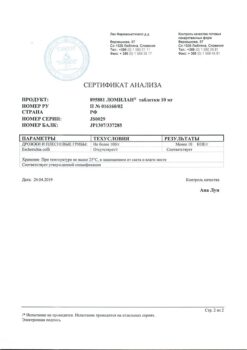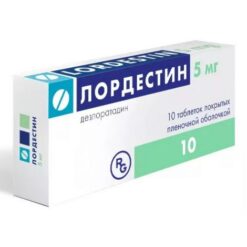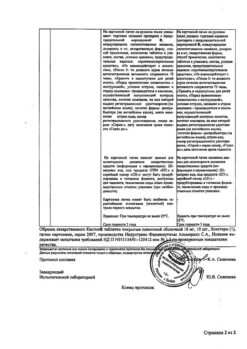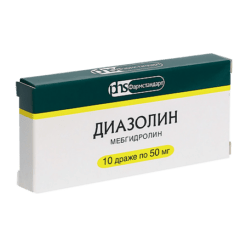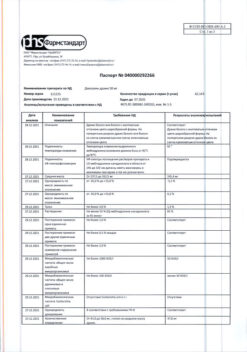No products in the cart.
Description
Pharmgroup: Anti-allergic agent – H1-histamine receptor blocker.
Pharmaceutical effect: Desloratadine is a long-acting antihistamine drug. It is the primary active metabolite of loratadine.
Inhibits the cascade of reactions of allergic inflammation, including Release of pro-inflammatory cytokines, including IL-4, IL-6, IL-8, IL-13, release of pro-inflammatory chemokines (RANTES), production of superoxide anions by activated polymorphonuclear neutrophils, eosinophil adhesion and chemotaxis, release of adhesion molecules such as P-selectin, IgE-mediated release of histamine, PG D2 and LT C4.
Hereby, it prevents development and facilitates the course of allergic reactions, has antipruritic and antiexudative effects, decreases capillary permeability and prevents development of tissue edema and smooth muscle spasm.
The drug has no effect on the CNS, practically has no sedative effect (does not cause sleepiness) and does not affect the speed of psychomotor reactions. It does not cause prolongation of QT interval on ECG. The action of the drug starts within 30 minutes after oral administration and lasts for 24 hours.
Pharmacokinetics: Plasma concentration of desloratadine can be determined 30 min after administration. Desloratadine is well absorbed, Tmax averages 3 h. It does not penetrate through the HEB. The bioavailability of desloratadine was proportional to the dose in the range from 5 to 20 mg. The binding to plasma proteins is 83-87%.
When using a dose of desloratadine (5 to 20 mg) once daily for 14 days, there are no signs of clinically significant cumulation of the drug.
The simultaneous intake of food or grapefruit juice has no effect on the distribution of desloratadine when administered at a dose of 7.5 mg once daily.
Desloratadine is not an inhibitor of CYP3A4 and CYP2D4 or a substrate or inhibitor of P-glycoprotein. It is intensively metabolized in the liver by hydroxylation to form 3-ON-desloratadine combined with glucuronide. Only a small portion of the ingested dose is excreted by the kidneys.
Indications
Indications
Active ingredient
Active ingredient
Composition
Composition
How to take, the dosage
How to take, the dosage
It is recommended that Eliseus be taken at the same time of day. The tablet should be swallowed whole, without chewing, with a small amount of water.
Adults and children over 12 years of age take the drug in a dose of 5 mg (1 tablet) 1 time daily, regardless of meals.
The duration of treatment depends on the severity and course of the disease.
The treatment of intermittent allergic rhinitis (presence of symptoms for less than 4 days per week or less than 4 weeks) must be guided by anamnestic and clinical data: discontinue after symptoms disappear and resume after their recurrence.
In persistent allergic rhinitis (presence of symptoms for more than 4 days per week or more than 4 weeks), treatment must continue for the duration of allergen exposure.
Interaction
Interaction
Clinically significant changes in plasma concentrations of the drug when repeated co-administration with ketoconazole, erythromycin, azithromycin, fluoxetine, cimetidine were not found.
Because the enzyme responsible for the metabolism of desloratadine has not been established, the possibility of interaction with other drugs cannot be completely excluded.
In clinical and pharmacological studies, desloratadine, when taken in combination with alcohol, did not increase the negative effects of ethanol on psychomotor function.
Special Instructions
Special Instructions
Impact on the ability to drive vehicles and operate machinery.
Patients should be informed that in very rare cases some people experience drowsiness, dizziness, which may affect their ability to drive and operate machinery.
In patients with high renal impairment, administration of Eliseus should be supervised by a physician.
Patients with rare hereditary manifestations of galactose intolerance, lactase deficiency or glucose and galactose malabsorption syndrome are contraindicated.
Children.
The efficacy and safety of use of Eliseus tablets in children under 12 years of age has not been established.
Contraindications
Contraindications
With caution: severe renal insufficiency.
Side effects
Side effects
Usually desloratadine is well tolerated, but sometimes side effects may occur. The most common side effects are fatigue, dry mouth and headache.
Mental disorders: hallucinations.
Nervous system disorders: headache, dizziness, somnolence, insomnia, psychomotor hyperactivity, seizures.
Heart disorders: tachycardia, palpitations.
Gastrointestinal disorders: dry mucous membranes of the mouth, diarrhea, abdominal pain, nausea, vomiting, dyspepsia.
Hepatobiliary system disorders: increased liver enzyme activity, increased bilirubin concentration, hepatitis.
Skeletal-muscular system and connective tissue: myalgia.
General disorders: hypersensitivity reactions (including anaphylaxis, angioedema, dyspnea, itching, rash and urticaria), increased fatigue.
Overdose
Overdose
Symptoms: no severe adverse reactions have been observed in clinical studies using doses 5 times higher than recommended. Drowsiness is possible.
Treatment: gastric lavage, administration of activated charcoal; if necessary – symptomatic therapy. Desloratadine is not excreted by hemodialysis; the effectiveness of its removal by peritoneal dialysis has not been established.
Similarities
Similarities
Additional information
| Manufacturer | Farmak, Ukraine |
|---|---|
| Medication form | pills |
| Brand | Farmak |
Related products
Buy Elysee, tablets 5 mg 30 pcs. with delivery to USA, UK, Europe and over 120 other countries.


